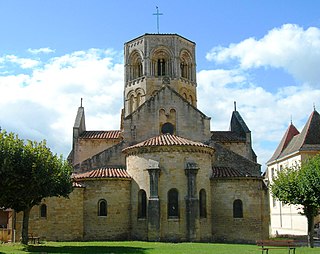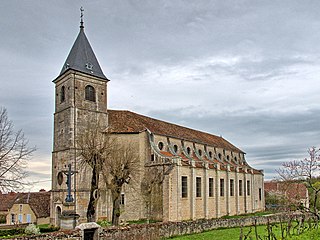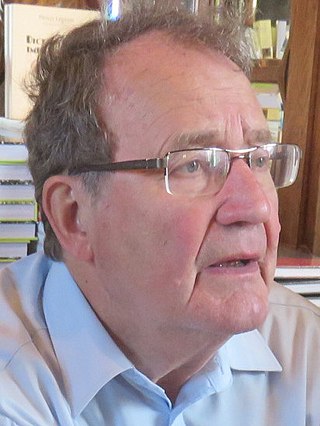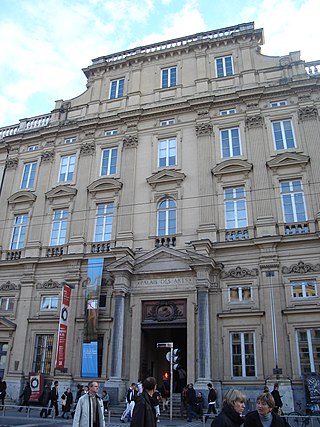
Auxonne is a commune in the Côte-d'Or department in the Bourgogne-Franche-Comté region of eastern France.

Chalon-sur-Saône is a city in the Saône-et-Loire department in the region of Bourgogne-Franche-Comté in eastern France.

Hugh, sometimes called Hugh the Great or Hugh of Semur, was the Abbot of Cluny from 1049 until his death. He was one of the most influential leaders of the monastic orders from the Middle Ages.

The arrondissement of Beaune is an arrondissement of France in the Côte-d'Or department in the Bourgogne-Franche-Comté region. It has 222 communes. Its population is 111,295 (2016), and its area is 2,359.1 km2 (910.9 sq mi).

The arrondissement of Charolles is an arrondissement of France in the Saône-et-Loire department in the Bourgogne-Franche-Comté region. It has 126 communes. Its population is 87,416 (2016), and its area is 2,443.8 km2 (943.6 sq mi).

Les Plus Beaux Villages de France is an independent association created in 1982 for the promotion of the tourist appeal of small rural villages with a rich cultural heritage. As of 2024, it numbers 176 member villages. It is affiliated to the international association The Most Beautiful Villages in the World.
Guerin, Garin, Warin, or Werner was the Count of Auvergne, Chalon, Mâcon, Autun, Arles and Duke of Provence, Burgundy, and Toulouse. Guerin established the region against the Saracens from a base of Marseille and fortified Chalon-sur-Saône (834). He took part in many campaigns during the civil wars that marked the reign of Louis the Pious (814–840) and after his death until the Treaty of Verdun (843). The primary sources for his life are charters and chronicles like the Vita Hludovici.

Mozac Abbey is a former Cluniac monastery in the commune of Mozac near Riom in Auvergne, France.

Semur-en-Brionnais is a commune in the Saône-et-Loire department in the region of Bourgogne-Franche-Comté in eastern France. It is a member of Les Plus Beaux Villages de France Association.

Gy is a commune in the Haute-Saône department in the region of Bourgogne-Franche-Comté in eastern France.

Genlis is a French commune in the Côte-d'Or department. The 20th-century archaeologist Jean Charbonneaux (1895–1969) was born in Genlis.

La Clayette is a commune in the east-central French department of Saône-et-Loire.
The Canton of Poix-de-Picardie is a canton situated in the department of the Somme and in the Hauts-de-France region of northern France.

John, called the Old (l'Antique), was a French nobleman, the Count of Auxonne and Chalon-sur-Saône in his own right and regent in right of his son, Hugh III, Count of Burgundy. In contemporary documents, he was sometimes called "Count of Burgundy", as by King William of Germany in 1251.
The Communauté de communes Somme-Sud-Ouest is a communauté de communes in the Somme département and in the Hauts-de-France région of France. It was formed on 1 January 2017 by the merger of the former Communauté de communes du Contynois, the Communauté de communes de la Région d'Oisemont and the Communauté de communes du Sud-Ouest Amiénois. It consists of 119 communes, and its seat is in Poix-de-Picardie. Its area is 909.2 km2, and its population was 38,575 in 2019.
The canton of Longvic is an administrative division of the Côte-d'Or department, eastern France. It was created at the French canton reorganisation which came into effect in March 2015. Its seat is in Longvic.
Dalmas I of Semur was a Burgundian nobleman.

The Charolais-Brionnais region is located in the southwest of the French department of the Saône-et-Loire in Burgundy. Created in 2004, the region comprises a population of 90,000 inhabitants across 129 municipalities.

Jean-François Bazin was a French politician, journalist, and writer.

The Abbey of Saint-Pierre-les-Nonnains in Lyon, also known as the Abbey of the Dames de Saint-Pierre or simply Palais Saint-Pierre, is an ancient Catholic religious edifice that housed Benedictine nuns from the 10th century onwards, and was rebuilt in the 17th century. Closed during the French Revolution, the former abbey is now home to the Musée des Beaux-Arts de Lyon.
This page is based on this
Wikipedia article Text is available under the
CC BY-SA 4.0 license; additional terms may apply.
Images, videos and audio are available under their respective licenses.

















